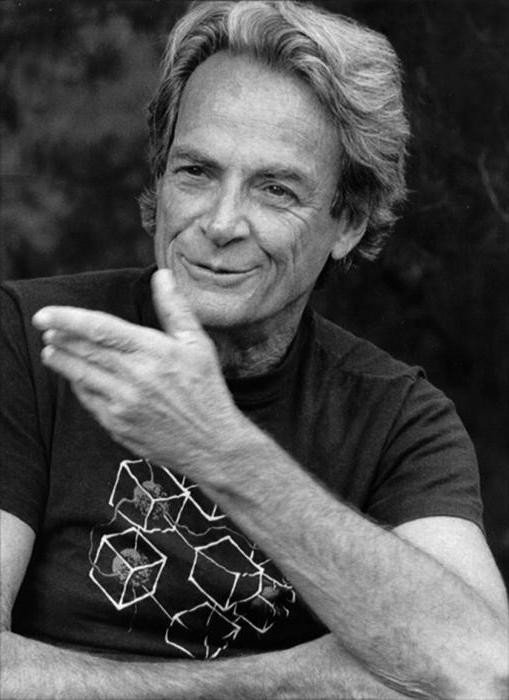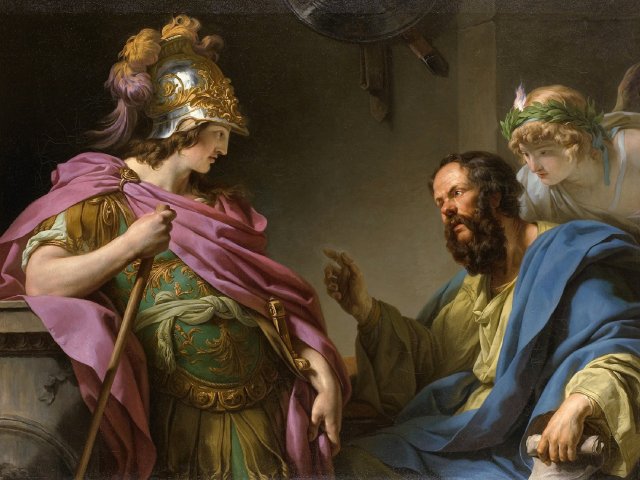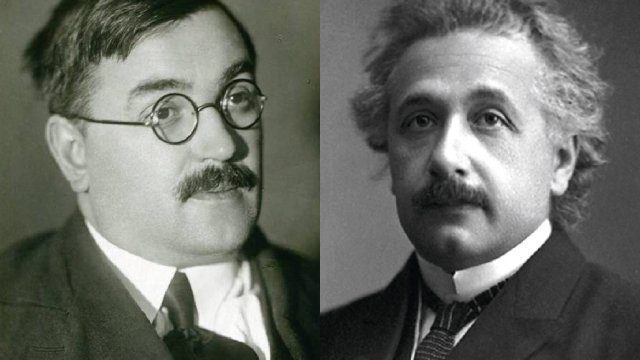Official:
Richard Phillips Feynman. May 11, 1918 – February 15, 1988. Outstanding American scientist. One of the creators of quantum electrodynamics, one of atomic bomb developers. Reformer of teaching methods used at teaching physics at universities. Laureate of the Nobel Prize in Physics.
Life and Work:
1. According to a survey conducted by the British magazine Physics World among scientists, Richard Feynman holds the seventh place on the list of the best physicists of all time – right after Galileo Galilei and before Dirac, Schrödinger and Rutherford.
2. In our country, the Nobel Prize winner and one of the atomic bomb creators is way less known than his neighbors from the list. Which is unfair: the great physicist and teacher of physicists, a complex and fascinating personality, according to Vitaly Ginzburg, who was a wonderful physicist and Nobel Prize winner too, is worth learning more about.
3. Feynman himself wrote his biography in just a few words. “Some facts of my life. I was born in the small town of Far Rockaway not far from New York, on the seaside, in 1918. I lived there till 1935. Then I spent four years studying at Massachusetts Institute of Technology, and, starting from 1939, I was transferred to Princeton. While working in Princeton, I took part in the Manhattan Project and, in April 1943, moved to Los Alamos. From October or November 1946 till 1951 I worked in Cornell. Then I was transferred to California Institute of Technology, where I work till now.”
4. All of these words are true, except that he does not work at California Institute of Technology now, because he died in 1988.
5. Details of his biography are also interesting. Feynman's father emigrated to the USA from the Russian Empire – from Minsk, his maternal grandparents also hailed from the Russian Empire – from Poland.
6. Melvill Arthur Feynman wanted his sun to build a career in science and put a lot of effort into his dream. He encouraged Richard's interest in the surrounding world since childhood, he did not shrug off his son's countless whys, but gave detailed answers filled with information about physics, chemistry and biology. Richard welcomed this food for thought.
7. Since he was 13, Feynman worked for money – he repaired his neighbors' radio sets. The neighbors were astonished: he did high quality work and did it quickly, but before snatching a screwdriver he took time to think where exactly the breakage was. And he often found it!
8. By the beginning of World War II, Feynman was a postgraduate student at Princeton. He tried to become a military volunteer, but, on mature deliberation, decided that there were other ways for a physicist to be useful at war. And he was right: Feynman took part in developing mechanical adding machines, which counted artillery trajectories. As there were no working computers back then!
9. Feynman did not really want to work at the atomic bomb, but decided it was better to join the project before the Nazis outran the USA.
10. Once, during Sunday tea at Princeton, Feynman shocked the dean's wife. When she asked, “What should I put in your tea, lemon or cream?" he answered, “Both, please.” The astounded reply got stuck in Feynman's memory, “Surely you're joking, Mr. Feynman!" It got stuck so deeply that he used it as a title for his book about his incredible life adventures.
11. An attentive reader will learn from this book that Feynman got enchanted by science and technology in childhood. Around that time, he also entertained the public by chemical miracles: he stealthily dipped his hand in water, then gasoline, and then held it above a burner. It was not painful – gasoline burned quickly, and water protected the skin. However, adult Feynman failed to repeat the trick – grown hairs on the hand played the role of wicks.
12. Feynman did not lose his passion for games and tricks till the end of his life and tried not to work with what was impossible to play with. According to his students, he found tremendous joy in science and physics, and transferred this joy to them.
13. His whole life was accompanied by the deep pleasure of scientific understanding, and so were all of his major works, from quantum electrodynamics to the theory of superfluidity.
14. Teaching brought Feynman great happiness. He spent three years on creating a new physics textbook, and the result of his labor was his second most famous book, The Feynman Lectures on Physics – a canonic interpretation of modern physics.
15. In his free time, he drew portraits, played the drums, analyzed Mayan scriptures and solved different riddles, including ciphers for safe boxes. He learnt to break open safe boxes back when he worked on the bomb – that was how he proved that safety measures were insufficient.
16. When he was 13, Richard Feynman fell in love with Arline Greenbaum. By the moment of their wedding, which took place when Feynman was working on his doctorate, it turned out that the bride was terminally ill with tuberculosis. Despite his family's protests, Feynman did not give up on his beloved. The wedding ceremony was performed on the way to a train station: the young man was heading to Los Alamos to work on the atomic bomb. The groom kissed the bride on the cheek, to avoid being infected.
17. In 1946, Arline died. Later Richard got married twice more. His last wife, Gwyneth, gave birth to their son Carl. Their daughter Michelle was adopted.
18. Richard Feynman's personal automobile had Feynman diagrams drawn on it – the ones that brought him the Nobel Prize.
19. The Infinity movie was filmed following Feynman's books. Its episodes feature the scientist's daughter Michelle and sister Joanne, who is an astrophysicist.
20. In the latter days of his life, Feynman took part in investigating the causes of the Challenger Disaster and came to the conclusion that must be carved into marble with golden letters, “For a successful technology, reality must take precedence over public relations, for nature cannot be fooled.”






















